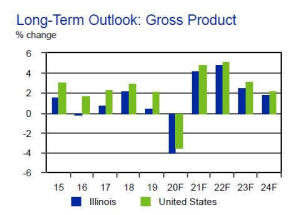Report: Illinois’ pension debt tops $300 billion
 Send a link to a friend
Send a link to a friend
[March 05, 2021]
By PETER HANCOCK
Capitol News Illinois
phancock@capitolnewsillinois.com
 SPRINGFIELD – A new report by the credit
rating agency Moody’s says Illinois will set a new record this year when
it reports a total net pension liability of more than $300 billion, the
highest of any state in the nation. SPRINGFIELD – A new report by the credit
rating agency Moody’s says Illinois will set a new record this year when
it reports a total net pension liability of more than $300 billion, the
highest of any state in the nation.
As of June 30, 2020, the report stated, the total unfunded liabilities
of the state’s five pension systems stood at $317 billion, a 19 percent
increase from the prior year. That was largely due to historically low
interest rates, which have depressed pension fund earnings throughout
the country.
With the state’s gross domestic product, or GDP, estimated to have
fallen 2.5 percent in calendar year 2020, that pension liability amounts
to roughly 37 percent of the state’s total economic output, up from a
range of 28-32 percent over the previous four years.
When combined with other long-term liabilities, including retiree health
care and bonded indebtedness, Moody’s estimates the state’s total
liability ratio will amount to 48 percent of GDP for the fiscal year
2021 reporting cycle.

The report says that 80 percent of the increase is attributable to
falling interest rates, but weaker-than-expected investment performance
also played a role. The Illinois Teachers’ Retirement System, the
largest of the five pension systems, reported investment returns of just
0.52 percent during the reporting period, far below its target of 7
percent.
“Illinois is an outlier among states both for fiscal challenges from
pension expenses and for its limited capacity to modify the benefit
packages that drive these expenses,” the report states. “The state
allocates about 30 percent of its budget to retirement benefits and debt
service, a ‘fixed-cost’ ratio more than three times the median for
states, and its constitution gives public workers some of the most
ironclad retirement benefit protections available.”
The report goes on to say that the amount that the state contributes to
its pension funds is actually far less than what is needed to prevent
continuing growth in their unfunded liabilities. Under current law, the
contribution amounts are set each year at a rate aimed at achieving a 90
percent funded ratio by 2045.
[to top of second column]
|

A graphic from the Commission on Government
Forecasting and Accountability's February 2021 economic forecast
shows the rate of growth for the state's gross domestic product
compared to that of the U.S. (Credit: Commission on Government
Forecasting and Accountability)

The report also notes that Gov. JB Pritzker’s proposed budget for
the fiscal year that begins July 1 lacks any broad plan to address
the state’s pension debt. But it also gave him credit for not
suggesting the state scale back on pension payments over the short
term to alleviate fiscal pressure brought on by the COVID-19
pandemic.
In a separate report to the state’s Commission on Government
Forecasting and Accountability, or COGFA, the consulting firm
Moody’s Analytics, a subsidiary of Moody’s Corp., said the state’s
fiscal condition could hamper its ability to recover smoothly from
the recession.
“Weak public finances mean Illinois will have to make extraordinary
fiscal adjustments that leave it playing catch-up in the next
business cycle,” the report stated. “Population loss and troubled
state finances will limit Illinois’ long-term potential.”
The report says the state’s economy is expected to start recovering
in earnest around mid-year and the unemployment rate should be under
6 percent by the end of the year, which would be in line with the
national average but higher than other Midwest states.
How quickly the economy recovers will largely depend on how quickly
the COVID-19 vaccines are delivered and how quickly the U.S.
population as a whole achieves “herd immunity,” which is currently
projected to happen by the fall.
“The economy should quickly kick into an extended period of strong
growth as people shed their fear of getting sick and get back to
doing what they did before the pandemic,” the report stated.
Capitol News Illinois is a nonprofit, nonpartisan
news service covering state government and distributed to more than
400 newspapers statewide. It is funded primarily by the Illinois
Press Foundation and the Robert R. McCormick Foundation. |